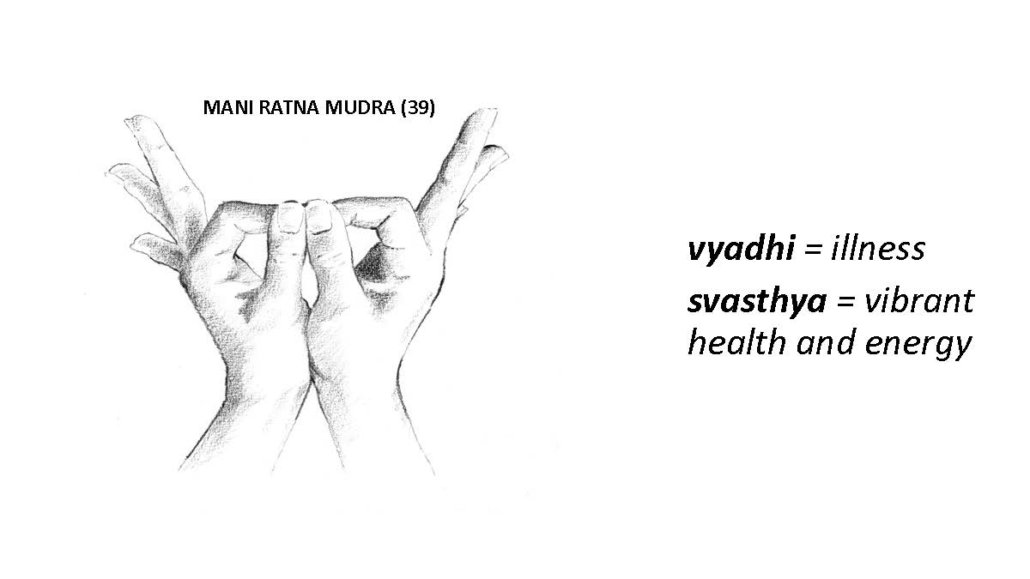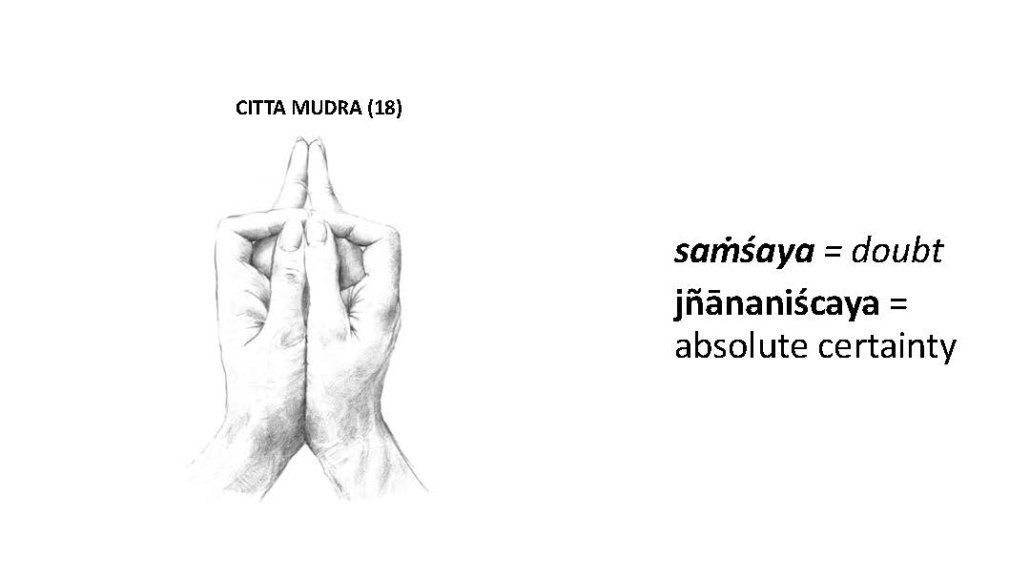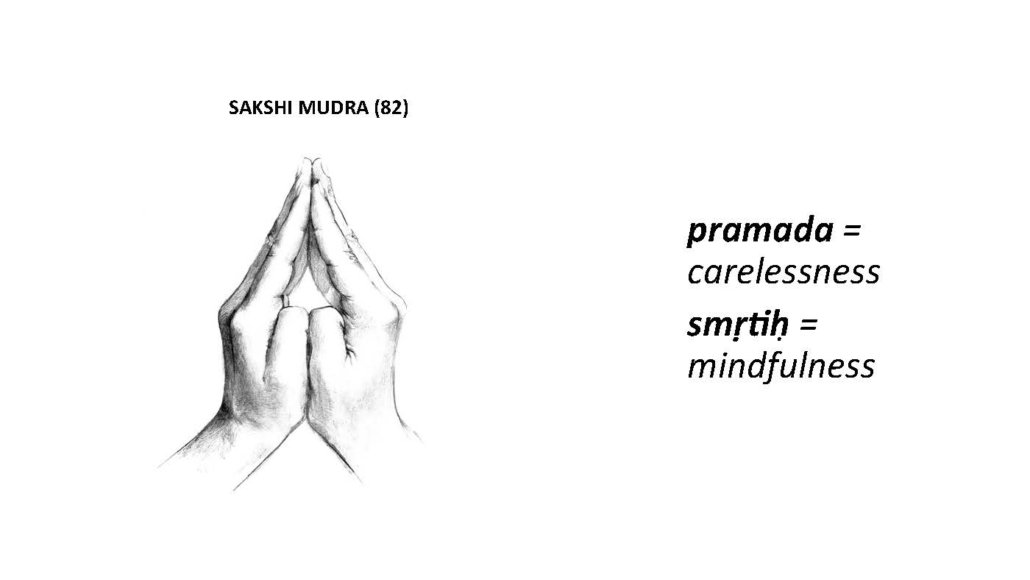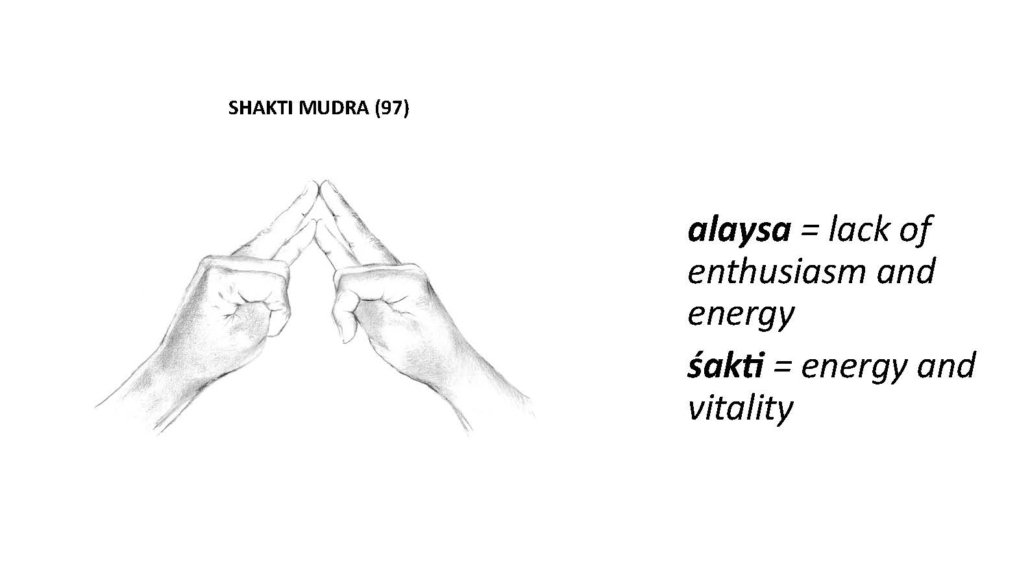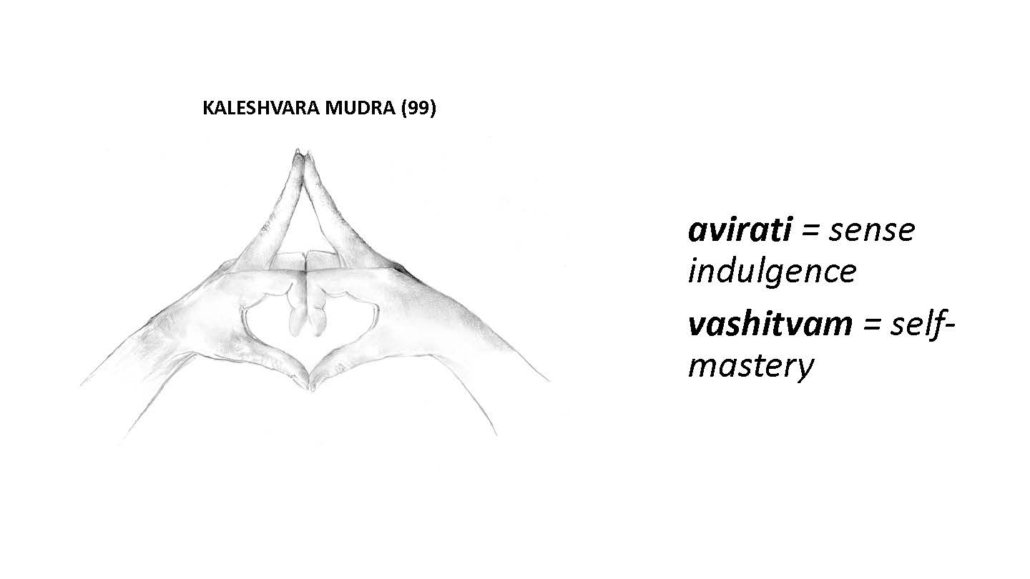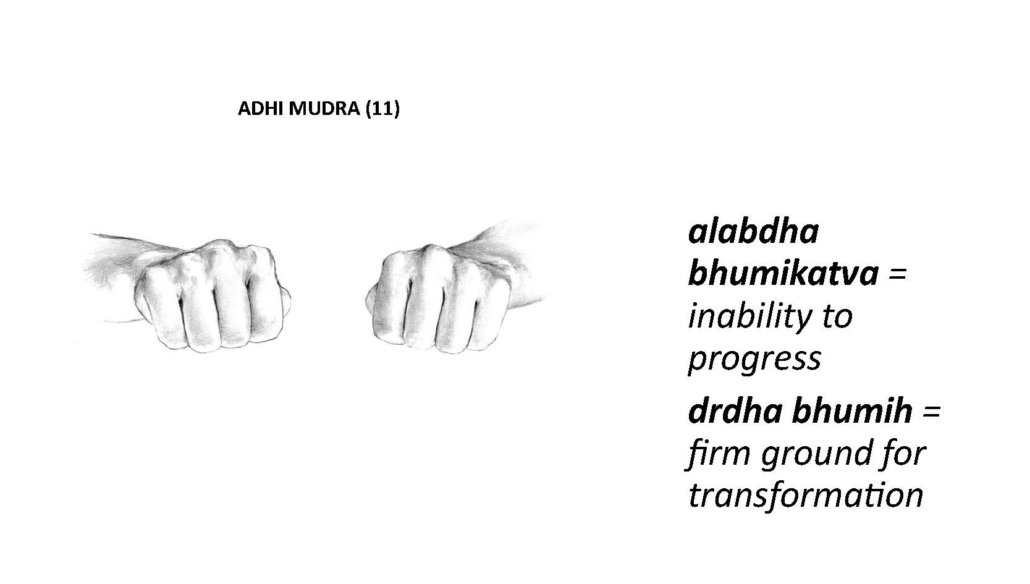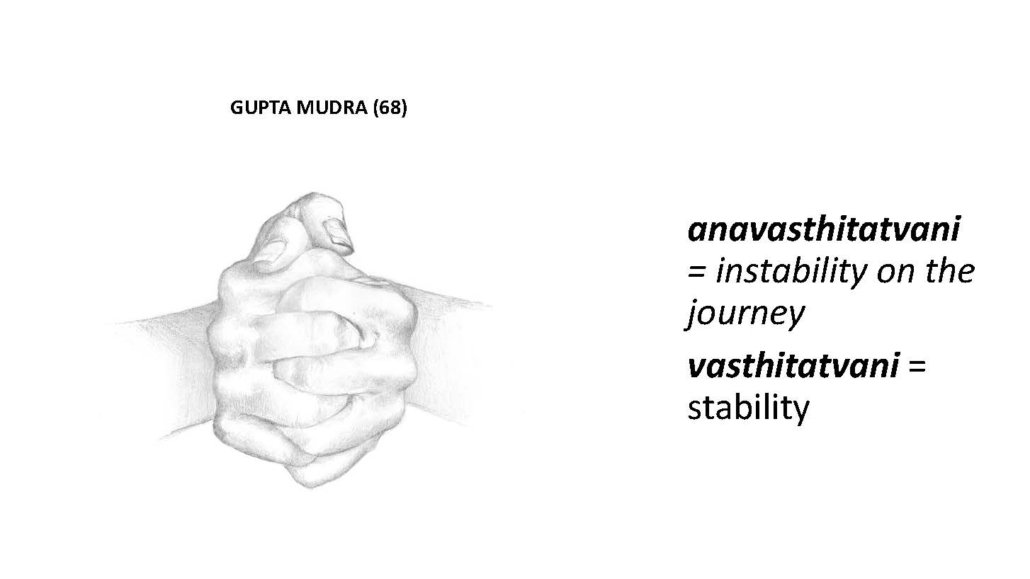The Yoga Sutras and Yoga Therapy
1.1 atha yogānuśāsanam
atha – now, therefore; yogaḥ – art and science of spiritual awakening; anuśāsanam – instruction, teaching, discipline
Now, when the student is prepared, instruction in Yoga begins.
- The word atha means “now” and also “therefore”, and both words are important in relation to Yoga Therapy.
- “Therefore” refers to a process that occurred to prepare us for the journey of Yoga. In the case of Yoga Therapy, this preparation is taking responsibility for your own health.
- In terms of the word “now”, Yoga Therapy always works in the present moment, so that the past, together with experiences of guilt or shame, are seen as patterns of thought and believe in the present moment.
- The root of the word anushasana is shas meaning instruction, but is also related to the word for sword, reflecting the need to cut through patterns of limiting conditioning in order to move toward optimal health.
- Shas is also related to the word sishya meaning a pupil or disciple, reflecting the need to find an authentic teacher that can guide us to health.
1.2 yogaś citta vṛtti nirodhaḥ
yogaḥ – the art and science of spiritual awakening; citta – mind-field; vṛttiḥ – movement, activity, modification; nirodhaḥ – stilling, cessation, restraint
Yoga is stilling the activity of the mind.
- There are two basic types of stilling the mind and both are important in Yoga Therapy.
- Yoga has a wide variety of techniques which support reducing the activity of the mind, especially in terms of reducing patterns of negative or destructive thinking. Asana, pranayama, mudra, meditation, and Yoga nidra, all play a role.
- The second way to still the mind is through witnessing, sakshitvam. In this way, the inner dialog and outer expression of this dialog continue, but we gradually learn to witness without repressing or reacting, thereby gradually reducing identification, which reduces the stress response and stress related illness.
1.3 tadā draṣṭuḥ svarūpe ’vasthānam
tadā – then; draṣṭuḥ – of the seer; svarūpa – true nature, true form; avasthānam – abides, is established, dwells
Then, when the movements of the mind have come into stillness, the seer abides in its own true nature.
- The word drashtu, referring to the one who sees, is important in that it emphasizes that recognition of our true Being is a question of clarity. In Yoga Therapy, we create an opening in which the care receiver comes to see for themselves the patterns of thought, feeling, relief, lifestyle, and diet that are the source of dis-ease.
1.4 vṛtti sārūpyam itaratra
vṛtti – activity, movements, fluctuations, modifications; sārūpyam – identification with, similarity, taking the form of; itaratra – elsewhere, otherwise, at other times
At other times, when not abiding in one’s own true nature, there is identification with the movements of the mind.
- One of the greatest obstacles in healing is the tendency to identify with one’s illness or limitation as “I” and “mine”. In Yoga Therapy, we reinforce the understanding that health conditions are not a permanent characteristic and that our true Self is the inner being that witnesses them.
- In this way, we create a space for disidentification with the cause of suffering.
1.5 vṛttayaḥ pañcatayyaḥ kliṣṭā ‘kliṣṭaḥ
vṛttayaḥ – activities of the mind; pañcatayyaḥ – of five kinds; kliṣṭa – painful;
akliṣṭaḥ – non-painful
The movements of the mind are of five kinds and are either painful or non-painful.
- This sutra is key to Yoga Therapy because it defines painful and non-painful in ways which are completely distinct from the norms upheld in our culture.
- Painful is anything that creates separation from our true Being, even if it may seem pleasurable in the moment. This includes all the way the body is abused in the name of pleasure, such as drinking, drugs, partying or even exercise or asana practice when they become addictions.
- Non-painful is everything that leads to union to our true Being, even if it is uncomfortable initially, including getting up early to practice meditation, or confronting core beliefs that bring up strong feelings.
1.11 anubhūta viṣayā ‘saṁpramoṣaḥ smṛtiḥ
anubhūtaḥ – experienced; viṣayaḥ – sense objects, objects of experience; asaṁpramoṣaḥ – retained, not forgotten, not released; smṛtiḥ – memory
Memory is the retention of sense objects experienced in the past.
- This sutra highlights the importance of bringing memories into the present moment where they can be experienced as reflections of current patterns of thought and belief, rather than past events which are no longer accessible.
- When these beliefs are worked with in the present moment and released, they no longer need to be retained.
1.12 abhyāsa-vairāgya-ābhyāṃ tan-nirodhaḥ
abhyāsaḥ – practice, effort, application, will; vairāgya – dispassion, non-attachment, uncolored; ābhyāṃ – of these two; tat – of those; nirodhaḥ – bringing into stillness, cessation
That stilling of those movements of the mind is accomplished through practice and non-attachment.
- The Yoga therapist works to awaken both these essential qualities in the care receiver. Practice is essential in reforming limiting patterns of diet, lifestyle, and belief.
- Non-attachment is part of the process of reminding the care receiver that they are already whole and complete. We do this by constantly reinforcing the positive qualities that Yoga awakens, including inherent self-esteem, and inner peace.
1.17 vitarka-vicārānandāsmitā-rūpānugamāt saṁprajñātaḥ
vitarka – cognitive reasoning; vicāra – intuitive understanding; ānanda – joy, bliss, ecstasy; asmitā – I-am-ness; rūpa – appearance of; anugamāt – accompanied by; saṁprajñātaḥ – samādhi supported by an object of meditation
Samprajñātah samādhi is accompanied by the sequential appearance of cognitive reasoning, intuitive understanding, bliss and “I-am-ness”.
- These levels of samadhi can be seen as levels of understanding of our own bodies. At the vitarka level, the body is a solid entity. At the vichara level, we understand it subtle dimension. At the ananda level, we discover that the body is a source of joy and ecstasy; and at the asmita level, we experience our deeper being, a greater Self, the “I” that inhabits the body.
- This path of samadhi is also the path of health in a greater sense.
1.20 śraddhā-vīrya- smṛtiḥ samādhi-prajñā-pūrvaka itareṣām
śraddhā – faith, confidence; vīrya – energy, strength, vitality, a firm decision, commitment, virility; smṛtiḥ– remembering, awareness, mindfulness; samādhi – meditation, concentration; prajñā – transcendent wisdom, knowledge; pūrvaka – preceded by; itareṣām – for others
For others, not born with a natural predisposition, attainment of asaṁprajñātaḥ samādhi is preceded by faith, energy, mindfulness, regular meditation practice and wisdom.
- These qualities are pre-condition for the effortless practice of samadhi but can also be seen as essential for whole person health.
- Faith is confidence in our own true Being and that healing is an intrinsic facet of this true Being.
- Virya is vitality, energy and strength, the essence of health. It unfolds naturally as we set a firm course toward recognition of our true Being.
- Smirtih is remembering, which is a way of saying that we can witness without identifying all forms of negative thinking which are the source of dis-ease through constantly remembering the inherent perfection of our true Being.
- Samadhi, in this sense, is reminder that changing old patterns can only occur through constant reinforcement of new patterns.
- Prajna means wisdom, and in relation to Yoga Therapy is the recognition that the entire life journey is a path of healing.
1.23 īśvara-praṇidhānād-vā
īśvara – Lord of creation; praṇidhānāt – through devotion, dedication, surrender; vā – or
Or, asaṁprajñātaḥ samādhi is experienced through surrender to Īśvara.
- Part of the process of healing is expanding our vision of ourselves beyond the conditioned personality with all of its wants, needs and perceived deficiencies.
- This larger vision is one of ourselves as part of the whole of Creation, the entire Universe.
- Ishvara is the energy Intelligence at the heart of the Universe. when we surrender to Ishvara, we surrender to our own greater Being whose very essence is healing.
1.27 tasya vācakaḥ praṇavaḥ
tasya – his; vācakaḥ – symbol, signifier, word, name; praṇavaḥ – OM
His, Īśvara’s, symbol is OM
1.28 taj-japaḥ tad-artha-bhāvanam
taj – that; japa – repetition, recitation; tad – that; artha – purpose, meaning;
bhāvanam – cultivation, realization
The repetition of that syllable OM leads to the realization of its purpose and meaning
- The Universe is created by the sound of OM, this is Ishvara voice calling the Universe into being.
- The Yoga Therapist can use sound, including the sound of OM, effectively as way to connecting the care receiver to the Source Energy, which is also the source of healing.
1.29 tataḥ pratyak-cetana-adhigamo-’py-antarāya-abhavaś-ca
tataḥ– through that; pratyak – inner; cetana – consciousness; adhigama – realization; api – also; antarāya – impediments; abhavaḥ – negation, absence, removal; ca – and
Through that repetition, consciousness of the inner true Self is realized and the impediments to the practice of samādhi are removed.
- This sutra reminds us that as Yoga therapist, we are always involved in two processes simultaneously.
- The first is reinforcing all the positive qualities awaken along the Yoga journey, beginning with relaxation, continuing with inner peace, and culminating in self-understanding.
- The second process is providing a lens through which the care receiver can see more clearly the impediments that they place in their own path to healing.
1.30 vyādhi styāna saṁśaya pramādālasyāvirati bhrānti darśanālabdha bhūmikatvānavasthitatvāni citta-vikṣepās te’ ntarāyāḥ
vyādhi – illness; styāna – dullness; saṁśaya – doubt; pramāda – carelessness; ālasya – lack of energy and enthusiasm; avirati – sense indulgence; bhrānti darśana – false views; alabdha bhūmikatva – failure to gain a firm ground; anavasthitatvāni – instability; citta-vikṣepāḥ – distractions of the mind field; te – they (are); antarāyāḥ – impediments
Illness, dullness, doubt, carelessness, lack of energy and enthusiasm, sense indulgence, false views, failure to gain a firm ground and instability are the distractions of the mind-field that are impediments to samādhi.
- Dis-ease, vyadhi, is first and foremost in this list, reminding us how challenging it is for care receivers with chronic illness to embark and remain on the journey of self-healing.
- One effective way for the Yoga Therapist to work with these antarayas is to reinforce their positive opposite qualities, supported by mudras:
1.31 duḥkha-daurmanasyṅāgam-ejayatva-śvāsapraśvāsāḥ vikṣepa sahabhuvaḥ
duḥkha – suffering, pain; daurmanasya – anguish, despair, depression;
aṅgamejayatva – trembling of the limbs, anxiety; śvāsa – inhalation; praśvāsāḥ – exhalation; vikṣepa – distraction, dispersion; sahabhuvaḥ – accompany, correlates, symptoms
Suffering, anguish, trembling of the limbs, erratic inhalation and exhalation accompany the distractions.
- These symptoms of the antarayas remind us that stress-related illness is not new, and that depression and anxiety were already a subject of concern for Patanjali.
- With this understanding, we remind ourselves that stress is the cause of most chronic illness, and that lack of self-knowledge is the cause of stress.
1.32 tat-pratiṣedhārtham-eka-tattvābhyāsaḥ
tat – these; pratiṣedha – counteract, prevent; artham – as a means of;
eka – one, single, unitary; tattva – principle, truth, quality; abhyāsaḥ – practice
As a means of counteracting these impediments, practice a single truth or principle
- Yoga tools and techniques are almost infinite in scope and variety. The texts of Hatha Yoga alone state that there are eighty-four thousand types of asanas.
- When working in Yoga Therapy however, it is often helpful to take a single tool, such as guided meditation, a mudra or an affirmation and make them the heart and focus of a healing practice.
Even when we use a variety of practices, and these progress over time depending on the students need, we can maintain one theme supported by various healing tools.
1.33 maitrī-karuṇā-muditopekṣāṇāṁ sukha-duḥkha-puṇyāpuṇya-viṣayāṇāṁ bhāvanātaś citta-prasādanam
maitrī – loving kindness; karuṇā – compassion; mudita – intrinsic joy;
upekṣāṇāṁ – neutrality, indifference; sukha – pleasure, comfort; duḥkha – pain, sorrow; puṇya – virtue, merit; apuṇya – non-virtue, demerit; viṣayāṇāṁ – in relation to, with regard to; bhāvanātaḥ – through cultivating; citta – mind field; prasādanam – clear, serene
The mind becomes clear and serene through the cultivation of loving kindness, compassion, intrinsic joy and neutrality in relation to pleasure and pain, virtue and absence of virtue.
- All of the values of the Yoga techniques and methodologies will be seen primarily and most importantly as changes in our attitude, beliefs and tendencies.
- These healthy attitudes are embodied in the four measurable qualities and these qualities will affect the overall functioning and health of both the mind and the body.
1.34 pracchardana-vidhāraṇābhyāṁ vā prāṇasya
Prachchhardana – exhalation; vidhāraṇābhyāṁ – control, regulation, retention;
vā – or; prāṇasya – of the breath
Or, the impediments to samādhi are overcome by exhalation and control of breath.
- This sutra deals with breath awareness as opposed to pranayama techniques, reminding the Yoga therapists that observing the care receiver breath and supporting them in bringing awareness to their breath are important tools for Yoga Therapy.
1.35 viṣayavatī vā pravr̥ttir utpannā manasaḥ sthiti nibandhinī
viṣayavatī – having sense experiences; vā – or; pravṛttiḥ – awareness, perception; utpannā – manifest, arisen; manasaḥ – of the mind; sthiti – stability, steadiness; nibandhinī – firmly establishes.
Or, awareness of the arising of sense experiences firmly establishes the stability of the mind.
- The ultimate goal of Yoga is self-mastery, but along this journey self-expression also has an important role to play.
- The Yoga therapist provides safe resources for feeling and expressing emotions, such as “Ha breathing”, and the release of sound and tension during asana practice.
- As Patanjali states, this emotional release, when done within the framework of Yoga Therapy, cultivates stability in the mind.
1.41 kṣīṇa-vṛtter abhijātasyeva maṇer-grahītṛ-grahaṇa-grāhyeṣu tat-stha-tad-añjanatā samāpattiḥ
kṣīṇa – weakened, diminished; vṛtteḥ – one whose mental fluctuations; abhijātasya – transparent, naturally pure, perfect; eva – like, as though; maṇeḥ – crystal, jewell, gem; grahītṛ – knower; grahaṇa – process of knowing; grāhyeṣu – the known, experienced objects; tat-stha – becoming focused, becoming stable; tad–añjanatā – taking the color of, taking the form of; samāpattiḥ – merging, fusion, engrossment, coalescence
When one’s mental fluctuations are weakened, consciousness becomes like a transparent crystal that can take on the color of whatever is placed before it whether that be the knower, the process of knowing or the object of knowing which naturally merge in samāpattiḥ.
- An important characteristic of dis-ease is the inability to see clearly. In this sutra, Patanjali reminds us that the essence of self-knowledge, which is also the essence of health, is gaining objectivity so that we see ourselves, other people, and life as a whole, as they are and not as we want them to be, or think they should be.
1.50 taj-jaḥ saṁskāro ’nya-saṁskāra-pratibandhī
tad – that; jaḥ – arising, born, produced; saṁskāraḥ – habitual latent impressions;
anya – (of) other; saṁskāraḥ – habitual latent impressions; pratibandhī – wipes away, inhibits, annuls, blocks
Impressions arising in r̥taṁbharā wipe away all other impressions.
- In the process of Yoga Therapy, the care receivers begin to experience positive sensations and qualities that arise within their own being.
- This begins with simple relaxation and the unfold as inherent joy, and finally, as an experience of knowledge of truth.
- This knowledge of truth infuses our entire being and erases all beliefs of defectiveness, which are replaced by absolute knowing of our life purpose and meaning.
- This knowing of truth is health in the deepest sense.
2.1 tapaḥ svādhyāyeśvara-praṇidhānāni kriyā-yogaḥ
tapaḥ – discipline, austerity; svādhyāya – self-study, study of scripture; Īśvara – The Lord; praṇidhānāni – surrender, devotion; kriyā – action, transformation; yogaḥ – union, integration
Kriyā-yogaḥ consists of discipline, self-study and surrender to the Lord.
2.2 samādhi-bhāvana-arthaḥ kleśa tanū-karaṇa-arthaś-ca
Samādhi – meditative absorption; bhāvana – realizing, cultivating;
arthaḥ – for the purpose of; kleśa – obstructions, afflictions; tanū – weakening, attenuating, diminishing; karaṇa – cause; arthaś – for the purpose of; ca – and
The purpose of kriyā-yoga is to realize samādhi and weaken the kleśas.
- Kriya Yoga can be seen as a roadmap to health.
- We begin by creating new patterns through practice and discipline. We engage in a process of inner observation to see all that has been limiting and destructive and also to visualize new ways of being.
- Finally, we awaken self-knowledge which is also knowledge of the whole Universe and of the energy and intelligence at the heart of the Universe.
2.3 avidyā-asmitā-rāga-dveṣa-abhiniveśaḥ kleśāḥ
avidyā – absence of wisdom, absence of knowledge of the true Self; asmitā – sense of individuality; rāga – desire, attachment; dveṣa – aversion, dislike; abhiniveśaḥ – fear of death, drive to survive, existential anxiety; kleśāḥ – root causes of suffering
Absence of knowledge of the true Self, identification with the limited personality, desire, aversion and fear of death are the kleśās, the root causes of suffering.
- The word klesha comes from the root klish, which means both impure and painful. The kleshas are therefore the root cause of dis-ease.
- The Yoga path is a lifelong journey of removing the kleshas and in the space of clarity created, recognizing our true Being which is synonymous with self-healing.
- The Yoga therapist, even when working with basic techniques, with a specific objective of relaxation and stress management, always keep the kleshas in view as the deeper source of dis-ease.
2.11 dhyāna heyāḥ tad-vr̥ttayaḥ
dhyāna – meditation; heyāḥ – dissolved, destroyed, resolved; tad – these; vr̥ttayaḥ – activities of the mind
These vrttis, the kleshas, are destroyed through meditation.
- All of the techniques we teach in Yoga Therapy are ultimately guiding the student toward an experience of meditation in the form of quieting the mind and eventually recognizing the inner I whose very nature is silence.
2.12 Kleśa mūlaḥ karma-aśayo dr̥ṣṭādr̥ṣṭa-janma-vedanīyaḥ
Kleśa – affliction; mūlaḥ – root, origin; karma – action; aśayaḥ – accumulation, storehouse; dr̥ṣṭa – seen (in this lifetime); adr̥ṣṭa – unseen, (from other incarnations); janma – births, incarnations; vedanīyaḥ – experienced
The kleśas are the root cause of the accumulation of karma experienced in this or other incarnations.
- We often think of karma as a storehouse accumulated in previous lifetimes, but karma is also the sum total of our thoughts, beliefs, lifestyle and activities in day-to-day living.
- The Yoga therapist creates an opening for the care receiver to see how the sum total of their karma is creating dis-ease.
- The Yoga therapist also creates an opening for the care receiver to see that a new incarnation, a new way of being can occur in any moment, when there is a willingness for genuine transformation.
2.15 pariṇāma tāpa saṁskāra duḥkhaiḥ guṇa-vr̥tti-virodhāc ca duḥkham-eva sarvaṁ vivekinaḥ
pariṇāma – transformation, change, effects, results, consequences; tāpa – anguish, suffering, acute anxiety; saṁskāra – imprints in memory, habit patterns; duḥkhaiḥ – pain, sorrow, suffering; guṇa – constituents of nature; vr̥tti – activities, fluctuations, modifications; virodhāt – internal opposition, conflict; ca – and; duḥkham – painful, sorrowful; eva – only; sarvaṁ – all: vivekinaḥ – to the discerning, to the wise.
For the discerning, all worldly experiences are painful because of the conflict and change inherent in the gunas leading to continual change in which experiences of anguish become habit patterns that deepen the experience of suffering.
- From the Yoga perspective, experience within the realm of prakriti, material reality, will never provide the knowledge, satisfaction, happiness, health, or peace that we seek.
- Within Yoga, we choose a completely different path in which all of life is seen as an experience of learning, leading to awakening.
- This understanding is key in Yoga Therapy because it is only in embracing this new way of seeing that health can unfold in the deepest sense.
2.16 heyaṁ duḥkham-anāgatam
heyaṁ – overcome, avoided, dissolved; duḥkham – suffering, pain; anāgatam – yet to come
The suffering yet to come can be avoided.
- This sutra reminds us that while the suffering and dis-ease of the past is real, it need not continue.
- By changing our attitude, priorities and use of time and energy, all forms of dis-ease can be released allowing us to continue into the future with health, happiness, and clarity.
2.33 vitarka bādhane pratipakṣa bhāvanaṁ
vitarka – negative thoughts; bādhane – disturbance; pratipakṣa – opposite thought or principle; bhāvanaṁ – cultivation
When these universal values and spiritual observances are disturbed by negative thoughts, the opposite positive thought should be cultivated.
- In Yoga Therapy, we need to create an opening where negative and limiting ways of seeing and being are replaced by positive ones.
- This is much more than an exercise in positive thinking and is embodied in the following process.
- Cultivating the skill to do the opposite of what our instincts tell us to do is referred to within the Yoga Sutras of Patanjali as pratypaksha bhavana, which literally means to visualize the opposite thought or quality as a response to all forms of negativity.
- Simply trying to think of something positive when we are feeling negative could lead to repression that could have negative consequences.
- Therefore, pratypaksha bhavana is not just replacing a negative thought with a positive one, but a process of understanding that allows us to transform negativity into positivity.
- This process makes use of pranayama techniques, including Kapalabhati:
-
- Bring to mind an issue that you are facing currently that generates any kind of negativity in the form of anger, fear, aversion, discomfort or annoyance. Notice the thoughts and feelings that accompany this pattern.
- Bring this situation and accompanying feelings into your body and notice where they live as well as their size, shape, color, texture and any accompanying symbols. Take some time to feel where this pattern lives within your being.
- Perform 27 rounds of Kapalabhati, developing openness and clarity to sense this pattern of thought and feeling even more clearly.
- Take some time to dialogue with this pattern of thought or feeling, basically allowing it to tell its story, how it perceived what happened and how it became hurt, frightened, angry, etc.
- Allow the others involved in this situation, even if it was in the distant past, to also tell their story, beginning to see that ours is not the only way to perceive the situation.
- Perform 27 more rounds of Kapalabhati, developing openness and clarity to see all the perspectives involved in the situation.
- Notice that this situation has an emotional charge for you currently, but that it is not new, since it reflects core beliefs that tend to recreate patterns of thought and feeling over and over, with different characters and different places, but the same general theme.
- Reflect on other similar situations you’ve been in, noticing how the pattern of thought and feeling are the same.
- See if you can identify a core belief within your own being that sustains these patterns of thought and feeling, that gives them energy.
- These core beliefs include a whole range of defense mechanisms developed early in life in order to protect ourselves from hurt and loss while trying to attain love, belonging and happiness.
- These beliefs include “I need to protect myself or others will hurt me,” “Life is never completely safe,” and, “I’m the only one who knows how to do it right.”
- Perform 27 more rounds of Kapalabhati and then rest in the space created to see if you can identify a core belief active in this current situation.
- When this core belief was developed, it was as a response to something positive you were trying to attain or achieve in your life, such as acceptance, belonging, recognition, love or even survival.
- Think back to when this core belief developed and notice what you really wanted. Notice where this positive quality lives in your body as well as their size, shape, color, texture and any accompanying symbols.
- Notice that you desired this positive quality so intensely because it is actually a reflection of your true Being, who you are beyond all the beliefs, conditioning and patterns of thought and feeling which are all superimposed externally. Take 27 more cycles of Kapalabhati to integrate this quality throughout your entire being.
- Reassess the current situation and your attitudes and visualize a way of thinking, feeling and responding that are pratypaksha bhavana, exactly the opposite of what you might normally think, feel or do, thereby supporting the release of all forms of limiting conditioning while supporting the recognition of your true Being.
- Visualize ways that this new attitude can be put into practice so that your needs are met, the maximum of harmony is created in your environment, so you stop creating similar situations in the future.
- Practice 27 more rounds of Kapalabhati to help visualize this new way of working with this type of situation.
3.23. maitryādiṣu balāniprakāśā ‘saṁprayoge ‘ntardhānam
maitrī – loving kindness; ādiṣu – and so forth; balāni – powers, stengths
By the practice of the threefold discipline on qualities like loving kindness, we come to embody that quality.
3.24. baleṣu hasti balādīni
baleṣu – in strengths; hasti – elephants; bala – strengths; ādīni – and so forth
By the practice of the threefold discipline on elephants, and so forth, we gain their strength.
- These sutras remind us of the power of visualization and imagery and how the Yogs therapist can use this to cultivate and reinforce positive attitudes and qualities.
3.29. nābhi cakre kāya vyūha jñānam
nābhi – navel; cakre – at the center; kāya – body, anatomy; vyūha – organization; jñānaṁ – knowledge
By samyama at the navel center, Maṇipura cakra, knowledge of the organization of the body is gained.
3.30. kaṇṭhakūpe kṣut pipāsā nivṛttih
kaṇṭha – throat; kūpe – well, pit, hollow; kṣut – hunger; pipāsā – thirst; nivṛttiḥ – cessation
By samyama at the pit of the throat, Viśuddha cakra, cessation of hunger and thirst is gained.
3.31. kūrma nāḍyāṁ sthairyaṁ
kūrma – tortoise; nāḍyāṁ – channel; sthairyaṁ – stability, steadiness, immobility
By samyama at the tortoise channel, Muladhara cakra, steadiness is gained.
3.32. mūrdha jyotiṣi siddha darśanam
mūrdha – of the head; jyotiṣi – on the light; siddha – masters; darśanaṁ – vision
By samyama on the light in the head, Sahasrara cakra, a vision of the masters is gained.
3.33. prātibhād vā sarvam
prātibhād – spontaneous enlightenment, flash of liberating intuition; vā – or; sarvaṁ – all
Or, through a liberating intuition at the third eye, Ajna chakra, all knowledge is gained.
3.34. hṛdaye citta saṁvit
hṛdaye – on the heart; citta – consciousness; saṁvit – full knowledge
By samyama on the heart, Anahata cakra, full knowledge of consciousness is gained.
- These sutras on the chakras remind the Yoga therapist that health and balance in the subtle body is a key aspect of overall health.
3.40. samāna jayāj jvalanaṁ
samāna – middle current of life force energy; jayāt – through mastery;
jvalanaṁ – radiance, brilliance, vitality
Through mastery of samāna, (the middle current of vital energy, one gains) radiance and vitality.
- This sutra on the prana vayus remind the Yoga therapist that these currents of subtle energy, which bring vitality to the physical body are a key facet of health and healing.
3.41. śrotrā ‘kāśayoḥ saṁbandha saṁyamād divyaṁ śrotram
śrotrā – ear, power of hearing; ākāśayoḥ – space; saṁbandha – relationship between; saṁyamāt – by saṁyama; divyaṁ – divine, supernatural; śrotraṁ – hearing
By saṁyama on the relationship between the space element and the power of hearing, divine hearing is attained.
3.44. sthūla svarūpa sūkṣmā ‘nvayārthavattva saṁyamād bhūta jayaḥ
sthūla – gross, material; svarūpa – essential nature, own form; sūkṣmā – subtle;
anvaya – interconnection, constitution, inherence; arthavattva – purposefulness; saṁyamād – through saṁyama; bhūta – the elements; jayaḥ – victory, mastery
bhūta – the elements; jayaḥ – victory, mastery
By saṁyama on the gross nature, essential nature, subtle nature, constitution and purpose of the elements in relation to purusha, one gains mastery over them.
3.45. tato ‘ṇimādi prādur bhāvaḥ kāya saṁpat tad dharmā ‘nabhighātaś ca
tataḥ – then; aṇima – becoming minute like an atom; ādi – and so forth;
prādurbhāvaḥ – appearance of, attainment; manifestation; kāya – body; saṁpat – perfection, excellence; tat – their (the elements’); dharma – constituents, characteristics, attributes; anabhighātaḥ – unafflicted, unaffected, immune from; ca – and
Then (from the mastery of the elements), sidhis such as becoming minute manifest along with perfection of body and its immunity (from the ravages of) the elements of nature.
3.46. rūpa lāvaṇya bala vajrasaṁhananatvāni kāya saṁpat
rūpa – form, beauty; lāvaṇya – grace; bala – strength; vajra – diamond like firmness; saṁhananatvāni – structures, constituents (these are); kāya – body; saṁpat – perfection
Beauty, grace, strength, and adamantine firmness constitute perfection of the body
- This sutra is dealing with the five elements both in their gross and their subtle form and their relationship to the senses reminds the Yoga therapist that working with this relationship is a key part of the healing process.
- Balancing the senses, the paired organs and the five elements with Anuloma Viloma Kapalabhati
- To attain this balance, we will practice Anuloma Viloma Kapalabhati with each of the senses and paired organs individually.
- Begin your pranayama and focus first on the left and right nostrils. Focus on the left as you exhale forcefully left and on the right as you exhale forcefully right for 18 cycles.
- As you breathe, also sense your connection to the earth element by visualizing a yellow square at the base of your body. After 18 cycles, release, taking three natural breaths to sense the balance of your nostrils and sinus passages and sense of smell, integrating the quality of grounding.
- Next, focus on your left and right cheeks and left and right sides of your mouth and tongue. Focus on the left as you exhale forcefully left and on the right as you exhale forcefully right for 18 cycles.
- As you breathe, also sense your connection to the water element by visualizing a silver blue crescent moon within your pelvis. After 18 cycles, release, sensing the balance within your cheeks, mouth, tongue and sense of taste, integrating the quality of fluidity.
- Next, focus on your left and right eyes. Focus on the left as you exhale forcefully left and on the right as you exhale forcefully right for 18 cycles.
- As you breathe, also sense your connection to the fire element by visualizing a downward-facing red triangle at your solar plexus. After 18 cycles, release, sensing the balance within your eyes and sense of sight, integrating the quality of clarity.
- Next, focus on your left and right lungs. Focus on the left as you exhale forcefully left and on the right as you exhale forcefully right for 18 cycles.
- As you breathe, also sense your connection to the air element by visualizing a six-pointed green star at your heart center. After 18 cycles, release, sensing the balance within your lungs and sense of touch, integrating the quality of harmony.
- Next, focus on the left and right hemispheres of your brain. Focus on the left as you exhale forcefully left and on the right as you exhale forcefully right for 18 cycles.
- As you breathe, also sense your connection to the integration of all the elements by visualizing the symbol OM at your third eye. After 18 cycles, release, sensing the balance of all your senses and paired organs in perfect harmony, integrating the quality of unity.


